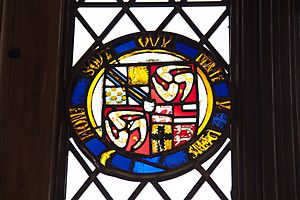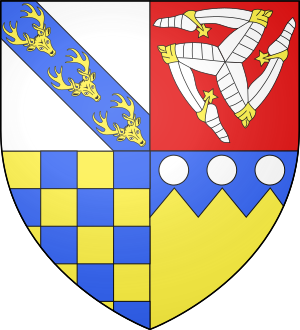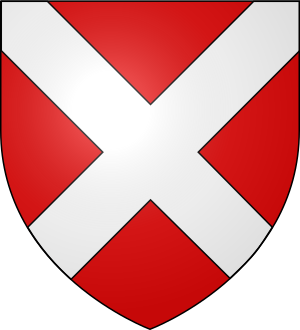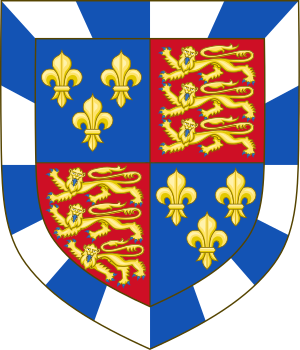Thomas Stanley, 1st Earl of Derby facts for kids
Quick facts for kids
Thomas Stanley
|
|
|---|---|
| Earl of Derby | |
| Born | 1435 |
| Died | 29 July 1504 (aged 69) |
| Spouse(s) |
|
| Issue | |
| Father | Thomas Stanley, 1st Baron Stanley |
| Mother | Joan Goushill |

Thomas Stanley, 1st Earl of Derby (born 1435, died 29 July 1504) was an important English nobleman. He was the stepfather of King Henry VII of England. He was the oldest son of Thomas Stanley, 1st Baron Stanley and Joan Goushill.
Thomas Stanley was very rich and powerful. He had a lot of land and influence, especially in northwest England. He was able to stay on good terms with different kings during the Wars of the Roses. This was a difficult time when two families, the Lancasters and the Yorks, fought for the English throne. Even King Richard III of England kept Stanley in his favor, though he once took Stanley's son as a hostage.
Thomas Stanley later supported Henry Tudor at the Battle of Bosworth in 1485. His large estates included places like Tatton Park in Cheshire and Lathom House in Lancashire.
Stanley's first marriage was to Eleanor Neville in the late 1450s. She was the daughter of a powerful Yorkist lord, Richard Neville, 5th Earl of Salisbury. This marriage created a strong link with the House of York. Later, in 1472, he married his second wife, Lady Margaret Beaufort. Her son, Henry Tudor, was the main claimant for the throne from the House of Lancaster. Thomas Stanley was the last person to use the title 'King of Mann'. After him, rulers of the Isle of Man used the title 'Lord of Mann'.
Contents
Becoming a Powerful Lord
When his father died in 1459, Thomas Stanley inherited many important titles. These included Baron Stanley and King of Mann. He also gained control of his father's large lands and positions in Cheshire and Lancashire. This was a huge inheritance. It gave him many chances to learn how to lead people.
His father had also been important in the king's household. This helped Thomas Stanley get an early start at court. In 1454, he was named among the squires of King Henry VI. But during the Wars of the Roses, this position was very dangerous. The two families fighting for the throne, the Lancasters and the Yorks, constantly demanded support from Stanley and his followers.
Choosing Sides in the Wars of the Roses
The Stanley family had supported the House of Lancaster for a long time. In 1399, they helped Henry Bolingbroke become king. Stanley's great-grandfather, Sir John Stanley, was greatly rewarded for his help.
After years of weak rule by the Lancastrian King Henry VI, the House of York challenged for the throne. This led to open warfare in the 1450s, known as the War of the Roses.
Battle of Blore Heath and Shifting Loyalties
In 1459, a peace agreement between the Lancastrian and Yorkist lords broke down. The fighting reached the Stanleys' lands. The Earl of Salisbury, Stanley's father-in-law, was gathering forces for the Yorkists. Queen Margaret of Anjou ordered Stanley to raise his own army to stop him. But when the two armies met at the Battle of Blore Heath in 1459, Stanley kept his 2,000 men out of the fight. His brother, Sir William Stanley, fought with the Yorkist army and was later punished.
By 1460, Lord Stanley began to work with the Yorkist lords. They now controlled the King and ruled in his name. Stanley quickly became a strong supporter of the new government. In the early 1460s, he joined his brother-in-law, Warwick, in fighting against the Lancastrian forces. The new King, Edward IV, needed Stanley to control the northwest. So, he confirmed Stanley's positions and payments.
Loyalty Divided Again
In the late 1460s, the group that had helped Edward IV become king started to break apart. Stanley found his loyalties divided once more. It was a confusing time with many changes in power.
When Warwick, fleeing from Edward in 1470, came to Manchester hoping for support, Stanley did not help him. But when Warwick returned, Stanley gave him armed support. This helped bring the House of Lancaster and Henry VI back to power. Lord Stanley was soon forgiven for his actions. After Edward IV became king again in 1471, Stanley was made steward of the king's household. He then became a regular member of the royal council.
His first wife, Eleanor Neville, died around this time. This ended his connection with Warwick and the Nevilles. In 1472, he made an even more important political marriage. His new wife, Lady Margaret Beaufort, was the mother of Henry Tudor. Henry was a possible heir for the House of Lancaster.
Stanley also played a role in military events. In 1475, he led several hundred men in a trip to France. In 1482, he served with a large group in a campaign in Scotland. This was led by the Duke of Gloucester, who later became King Richard III. Stanley helped capture Berwick upon Tweed.
Richard III and the Stanleys
After King Edward IV died unexpectedly in 1483, his twelve-year-old son Edward V became king. Stanley tried to keep a balance of power between the young king's uncle, Richard, Duke of Gloucester, and the Woodville family. Stanley's own son, George Stanley, Lord Strange, was married to a relative of the Woodvilles.
In June 1483, Gloucester attacked this group at a council meeting. Stanley was hurt and put in prison. But he was spared the fate of Lord Hastings, who was quickly executed. That month, Parliament said that Edward V and his younger brother, Richard, Duke of York (known as the Princes in the Tower), were not legitimate heirs. This was because their father, Edward IV, had supposedly been promised to marry someone else before marrying Elizabeth Woodville. So, the Duke of Gloucester was declared King Richard III.
Richard III wanted to keep the powerful Stanley family on his side. Lord Stanley was soon released from prison. He continued as steward of the royal household. He seemed to be doing well under the new king. Stanley carried the great mace at Richard's coronation. His wife carried the new queen's dress. Richard took away all of Stanley's wife, Margaret Beaufort's, titles and possessions because she was involved in "treason." But he gave all her properties to Stanley, which meant she didn't lose much.
Stanley was also made a Knight of the Order of the Garter. This was a very important honor. In the autumn of 1483, several plots against the King came together in Buckingham's rebellion. This was a rebellion in southern and western England. When Richard went to stop the rebellion, Stanley and his brother William were with the King. They were greatly rewarded with lands taken from the rebels. Stanley was also made Lord High Constable of England.
Stanley's wife, Margaret Beaufort, was a key planner in the rebellion. She arranged for Edward IV's daughter, Elizabeth of York, to marry her son, Henry Tudor. Stanley had to promise Richard that he would keep his wife under guard and stop her plotting. This saved her from disgrace and likely saved his own position too. Richard knew the Stanleys were a threat. In the summer of 1485, when Stanley asked to leave court, the king made his son, George Stanley, stay at court. This was a guarantee of his father's good behavior.
The Battle of Bosworth
The Stanleys had been talking with Henry Tudor, who was in exile, for some time. Tudor's plan was to land in Wales and march east into central England. This plan relied on the agreement of Sir William Stanley and Lord Stanley.
When Richard heard about the invasion, he ordered the two Stanleys to gather their men to fight the invader. But when it was clear that Tudor was marching through Wales without being stopped, Richard ordered Lord Stanley to join him right away. Lord Stanley said he was sick. By now, Richard had proof that the Stanleys were involved with Tudor. Lord Strange, Stanley's son, confessed that he and his uncle, Sir William Stanley, had planned with Henry Tudor. Richard called Lord Strange a traitor. He said that Strange's life was a hostage for his father's loyalty in the coming battle. Richard supposedly ordered Strange to be executed on the battlefield, but this never happened. Lord Stanley's answer to Richard's threat was reportedly: "Sire, I have other sons."
Three armies moved into the midlands. First, Lord Stanley and his forces. Then, Sir William Stanley. Finally, Henry Tudor and his army. On August 22, when the Stanley forces arrived south of Market Bosworth, they took a position separate from both the king's army and the rebel army. Lord Stanley did not directly join the fight. He stood still between the two armies. It was Sir William's important action that gave Henry the victory.
After Richard was defeated, the crown he wore into battle was found. A historian named Polydore Vergil wrote that Lord Stanley picked it up and placed it on his stepson's head. His cheering troops watched. This showed how important the Stanleys were in helping Henry Tudor become king.
Rewards and Challenges
Henry Tudor showed his thanks to his "dearly beloved father" by making him Earl of Derby on October 27, 1485. The next year, he confirmed Stanley as Lord High Constable of England and High Steward of the Duchy of Lancaster. He also gave him other lands and positions. In 1486, Stanley also became the godfather to Henry's oldest son, Arthur, Prince of Wales.
Even so, during the Lambert Simnel uprising in 1487, some people worried that the Stanleys were not fully committed. There was relief when the Stanley forces finally joined the king's army at Nottingham.
After the Battle of Stoke, which ended this uprising, Stanley received even more rewards. He gained lands from defeated lords in Lancashire and other places. In 1489, the Stanleys again helped the army raised by Henry to stop an uprising in Yorkshire. However, Stanley's brother William unwisely supported a later pretender, Perkin Warbeck. Because of this, he was executed for treason in 1495.
Powerful in Northwest England
Throughout his life, Thomas Stanley worked to keep and increase his power as a regional leader. Changes in who was king never really weakened his control over important positions in Chester and Lancaster. He built on what he inherited from his father. He made sure his family's power grew across the northwest.
Because he held so many positions both regionally and at court, he did not need to spend his own money to give out favors to many people. He also helped settle local arguments. Even state matters were often sent to him to decide. However, being a "good lord" also meant being tough. The Stanleys did not allow anyone to oppose them. They tolerated few rivals in the areas they controlled.
Death and Family
Thomas Stanley died at Lathom, Lancashire, on July 29, 1504. He was buried in the family chapel at Burscough Priory, near Ormskirk in Lancashire. His oldest son and heir, George Stanley, Lord Strange, had died a few months before him. So, his grandson, Thomas Stanley, 2nd Earl of Derby, became the next Earl.
In his will, written on July 28, 1504, he asked for prayers for himself, his wives, parents, ancestors, children, and siblings. He also remembered "them that have died in the service of my lord my father or of me."
Marriages and Children
Thomas Stanley married two times:
First Marriage
His first marriage was in 1451, to Eleanor Neville (died 1472). She was the daughter of Richard Neville, 5th Earl of Salisbury. Eleanor died in 1472 and was buried in London. They had eleven children, but many died young. Three of their sons became very important:
- John Stanley, their oldest son, died young.
- George Stanley, 9th Baron Strange (1460–1503). He was the second surviving son. He died a year before his father, leaving a son named Thomas Stanley, 2nd Earl of Derby.
- Richard Stanley, their third son, died young.
- Edward Stanley, 1st Baron Monteagle (1462–1524).
- James Stanley (1465–1515), who became the Bishop of Ely.
- Thomas Stanley, died in 1475.
- William Stanley, died young.
- Anne Stanley, died young.
- Alice Stanley, died young.
- Katherine Stanley, died young.
- Agnes Stanley, died young.
Second Marriage
His second marriage was in 1472 to Lady Margaret Beaufort (1441/3-1509). She was the daughter of John Beaufort, 1st Duke of Somerset. Lady Margaret Beaufort was the mother of Henry Tudor, who became King Henry VII in 1485. Thomas Stanley and Lady Margaret Beaufort did not have any children together.
Legacy and Family Today
When he died, Lord Stanley had been involved in politics for 45 years. He had been very successful in difficult times. He avoided the violent deaths that many other powerful people faced. He gained huge estates and important national positions. He was also given the Order of the Garter and an earldom.
His close connections to several royal families made him very powerful. Under his clever leadership, the northwest of England avoided the worst parts of the civil war. His family helped bring culture and refinement to the region. They also supported the careers of many young men from Lancashire. These men later became important leaders in the church and government.
The main line of Thomas Stanley's descendants continued to hold the Earldom of Derby until 1736. The title then passed to a different branch of the family. This branch still holds the title today. Edward Stanley, born in 1962, became the 19th Earl of Derby in 1994.




